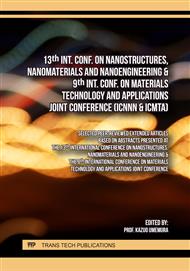p.3
p.9
p.17
p.25
p.31
p.39
p.47
p.73
Strategic Development of Nanoemulsion Bases for Versatile Active Ingredient Incorporation
Abstract:
Olive oil is widely used in cosmetics, food, and pharmaceuticals, and oil-in-water (O/W) nanoemulsions have gained attention in recent years due to their ease of preparation, cost-effectiveness, and enhanced efficacy. However, the high costs associated with advanced technologies hinder small enterprises from adopting these formulations, limiting global competitiveness. This study aims to develop olive oil-based nanoemulsions (ONEs) as versatile carriers for active ingredients in various industrial applications. The research focused on creating O/W nanoemulsions using the D-phase emulsification (DPE) method, known for its low-energy consumption and simplicity. The impact of surfactants, co-surfactants, glycerol, oil content, initial water addition, and stirring time on the particle size and polydispersity index (PDI) was studied. The optimized formulation with a single surfactant had a particle size of 10.03 ± 3.08 nm and a PDI of 0.343 ± 0.024, while the use of co-surfactants resulted in a particle size of 200.13 ± 3.03 nm and a PDI of 0.145 ± 0.000. The co-surfactant formulation demonstrated stability at 35°C over 4 months. Furthermore, retinol was incorporated into the optimized nanoemulsion, and the physical properties were compared to those of the base formulation. The particle size and PDI remained similar, suggesting that the formulation is robust enough for active ingredient incorporation. This research provides a foundation for future formulation efforts, offering a cost-effective and efficient approach for industrial applications.
Info:
Periodical:
Pages:
9-16
Citation:
Online since:
December 2024
Authors:
Keywords:
Price:
Сopyright:
© 2024 Trans Tech Publications Ltd. All Rights Reserved
Share:
Citation:



